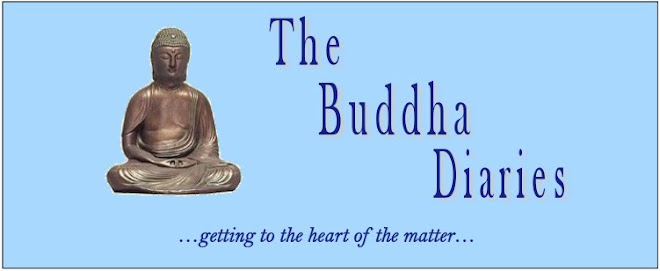... INSTALLATION! We cheated a bit on the "One Hour/One Painting" format at Shulamit Gallery down in Venice yesterday evening, in part because the relatively small space (and the relatively big group of participants) suggested a change from the usual pattern of sitting in front of a single work; in part because the work itself, by the artist Doni Silver Simons, seemed to call for consideration as an installation rather than a unique piece.
The artist's title for the curatorial selection of her works was "de.noue.ment," the French words usually used in theater terminology to describe the unwinding and resolution of a plot. Literally, it means "unknotting," which is a precise description of much of Simons's work: she typically uses canvas as her medium, not to paint on, but to take apart. She deconstructs the closely woven threads, allowing the edges to fray and individual strands, or groups of them, to flow out and away from the remaining surface. The process is sometimes presented as performance, sometimes recorded as video, sometimes preserved as two- or three-dimensional objects to be hung, or displayed in relief against the wall. The results, to the patient, "slow" observer, are mesmerizing.
We started the hour with a wall panel video where small strands of thread appear from nowhere and fall gently from a monochrome white panel, to the left, alighting and gathering like leaves in a brown panel to the left--a simple "action" that compels the viewer's attention with its repetitive simplicity. After twenty minutes with this compelling piece, we attempted to maintain concentration and composure as we shifted stools and chairs and regrouped in front of a wall relief composed of a long, unrolling stretch of torn canvas, seeming to drop its remnant shreds into a rusting bucket installed beneath. Here, as best we could with the number of bodies at stake, we risked the movement necessitated by the art work itself, in order to be seen properly--side to side, and forward and back, noting the highlights and shadows, the textures, and the details of the tear.
And finally, with the same mindful movements, the group turned to a third piece--a triptych of tall free-standing panels, the two side panels echoing each other, the slightly wider central panel richer in texture and more majestic in the waterfall of canvas that made up its surface. Given time, this seemingly simple work proved as compelling--and indeed, I'd almost say as sacred--as the triptych you might find in a church or synagogue, inspiring a sense of serenity and awe that proved to be truly elevating to the spirit.
No matter the change in format and the increased level of difficulty because of the added element of movement, the response from all the participants was enthusiastic. More than ever, I myself enjoy the process, and the confidence I feel in its value and importance clearly is projected in my presentation. This was my last scheduled "One Hour/One Painting" session of the season, though I have two more invitations awaiting confirmation. If they come through, I will post and disseminate information in the usual ways, and encourage those of you in the Southern California area to give this unique experiment in slow looking a try.
A final note: my new assistant, Adam, is now taking on the role of my publicist as I begin to put together a schedule for the fall, winter and spring of the next season. I have become so passionate about the value of "One Hour/One Painting" that I would love to have the opportunity to take it further out along the road. In addition to OH/OP sessions, I am offering a related "lecture/demonstration" that will combine discussion of the benefits and value of "slow looking" with a demonstration of the process. I see it as something that would be as appropriate for museum docent groups as for schools and colleges; and I would of course welcome interest, referrals and inquiries from readers of The Buddha Diaries.
Wednesday, May 1, 2013
Subscribe to:
Post Comments (Atom)







No comments:
Post a Comment